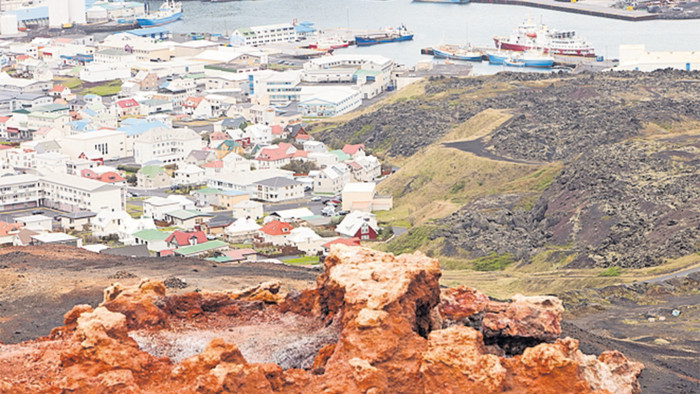Time travel in Heimaey, Iceland

Simply sign up to the Life & Arts myFT Digest -- delivered directly to your inbox.
In the shadow of a blood-red volcano on a remote island off the southern coast of Iceland, a museum dubbed “the Pompeii of the north” is taking shape.
It’s a tribute, of sorts, to the volcanic eruption which devastated the island of Heimaey 41 years ago and forced thousands of inhabitants to flee to the mainland. The eruption lasted five months, spewing lava which gradually smothered houses and threatened to block the harbour, thus crippling the fishing fleet that was the main income source.
At the centre of the new museum stands an entire house meticulously freed of the volcanic ash that once enveloped and preserved it. The dusty walls, which have retained their glossy orange paint, are the architectural bones of a painstaking excavation.
Standing on a carpet covered in grit and rubble, it still takes imagination to picture just how the Eldheimar (“Worlds of Fire”) museum will look when it opens in May. Workmen wearing high-visibility vests stroll past, shouldering screens for exhibition spaces that will tell the story of the January 1973 eruption, which destroyed 400 homes.
When complete, the house will display everyday objects from the period – cutlery, furniture and so on – rather than the Roman frescoes boasted by its illustrious Italian equivalent. Each item was carefully removed as the house was excavated and the museum built around it. But when the exhibit is completed – and everything is put back just as it was – the house will give a snapshot of the life of islanders in the early 1970s. This is time travel the Icelandic way.
Curving above the two-storey house is a soon-to-be-completed glass bridge. This vantage point will give a perfect view of what was buried under the 15m-thick layer of pumice that shrouded the mortar and preserved the contents.
My guide, Kristin Johannsdottir, says the project is “a unique, modern archaeology dig as well as being a bit like returning to the scene of the crime”. She tells me there is hope that this novel form of time travel will bring more tourism to Heimaey, the only inhabited island of the remote Vestmannaeyjar archipelago.
Currently, aside from brooding landscapes and wild seas, the island offers tourists a rather eccentric range of attractions: the world’s only golf course in a crater; a Norse timber church gifted from the people of Norway; a black pole of lava on a residential road that marks how high the ash piled up, and a small natural history museum where two domesticated puffins pad around freely on the tiled floor.
The one hotel of note, the Hótel Vestmannaeyjar (hotelvestmannaeyjar.is), is being expanded in time for the museum opening.
One of the other focal points for the island’s community of 4,200 people is the Vinaminni Kaffihús, run by Helga Jonsdottir and her husband Arnor Hermannsonn.
My guide and I head there next, passing Eldfell, the 200m-high volcanic cone which formed out of the giant fissure that nearly ripped the island in two in 1973. It looms ominously in the east, squatting under a thin duvet of snow, its red surface just visible.
Vinaminni Kaffihús is the kind of café you’d find in chic urban neighbourhoods around the world but for the tables, which commemorate the eruption.
Under the glass at the table where we sit down, a colourful montage shows a family standing in front of their two-storey house. Their evacuation tale, of seasickness, 10m waves and seven hours on tiny fishing vessels heading to the mainland, is told in text.
Pointing to the photos, Jonsdottir says: “The eastern side used to be the most beautiful part of the island. Now all we can see is this ugly volcano.”
Miraculously, the local fishing fleet safely ferried 5,273 people to the mainland where many chose to stay as eruption refugees. Only one of the islanders died, in a gas explosion. “We feared that if the volcano didn’t kill us, the sea would,” Jonsdottir said. “For us, there is the time before and the time after. We wanted to turn our bakery into a memorial café, so that people will never forget what we have lost.”
——————————————-
Details
Caroline Eden was a guest of Visit Iceland (visiticeland.com). Return international flights with WOW Air (wowair.co.uk) from London to Reykjavik cost from £138. Eagle Air (eagleair.is) flies daily (except Saturdays) from Reykjavik to Heimaey, Vestmannaeyjar, weather permitting; returns from £210
Comments